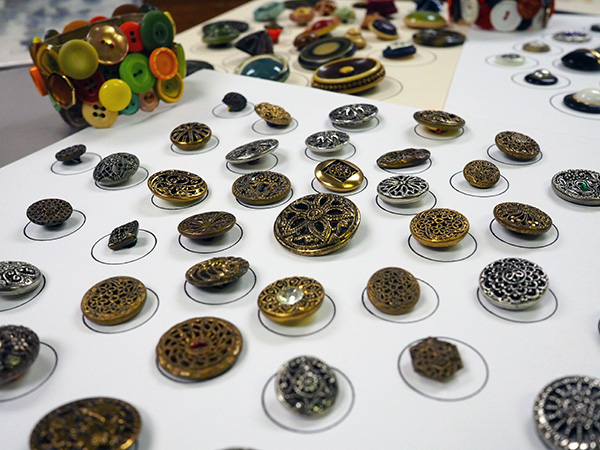Buttons are main accessory at Marble Falls workshop

DANIEL CLIFTON • PICAYUNE EDITOR
MARBLE FALLS — Janet Graves pulled out an 8-inch-by-10-inch placard and pointed out several of the buttons attached to it.
“These are moon glows,” she explained. The bottoms come in several sizes and colors. “If you take a close look at it, it has a clear pieces of glass over the color.”
A little scrutiny determined Graves was correct. A thin piece of glass is wrapped around the center part of the button. Graves, a hobby button collector, showed off several more placards containing the ubiquitous fasteners. Some are larger, others are “diminutive.” In fact, there’s even a class of diminutives. One card holds several ornately designed buttons, while others are more mundane.
Who knew buttons came in such a variety of styles, types and designs? When most people think about buttons, the four-hole, shirt button usually pops to mind.
“Buttons are very fascinating,” Graves said.
On Sept. 27, the Bluebonnet Button Club is hosting the State Fall Button Workshop at First United Methodist Church, 1101 Bluebonnet Drive. The event is 9 a.m.-4 p.m., and admission is free.
When the subject of button collecting comes up, many think of political campaign buttons. But there’s an entire world of button aficionados who prefer the ones typically associated with fastening things. Yet buttons were created several thousand years ago as ornaments and seals. Some of the oldest-known buttons date to the Indus Valley Civilization about 2,600 to 2,800 B.C. and ancient Rome.

As the button transitioned into its role as a fastener, many retained a artistic quality to them, far more so than the four-hole button with which most of us are familiar. Craftsmen and women often cut detailed designs into buttons.
“Metal buttons can have very detailed pictures on them,” Graves added. “The detail is just outstanding.”
By looking closer at many of these buttons, you notice the way the maker layered textures and colors into the design.
Graves, who considers herself a hobbiest in the button-collecting world, has found buttons fascinating since her youth. As a kindergarten teacher, Graves used tubs of buttons in teaching counting, sorting and other activities.
“Buttons are great for teaching math concepts,” she said.
It was only after her retirement that Graves began delving into the more artistic side of buttons.
She looked over another placard of buttons — celluloid ones. When asked how somebody made the buttons, Graves admitted with a smile that she didn’t know. “But that’s whats so interesting about buttons, you can always learn more.”
Along with collectors from across the state, the State Fall Button Workshop will include vendors and button experts.
And, of course, buttons. Lots of buttons.
The workshop is only one way to learn about buttons. The Bluebonnet Button Club meets 10 a.m. the first Wednesday of the month in the AgriLife Extension Service conference room at the Burnet County Annex, 1701 E. Polk St. (Texas 29) in Burnet.
daniel@thepicayune.com

